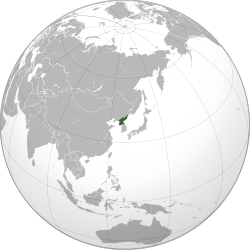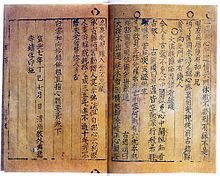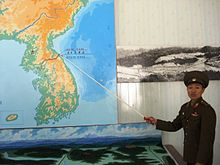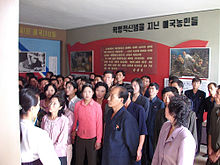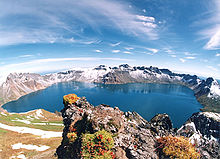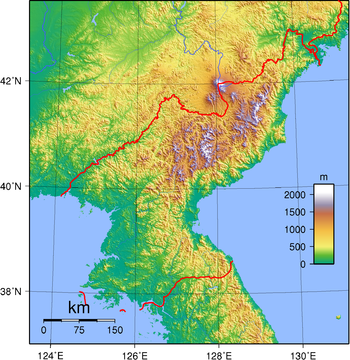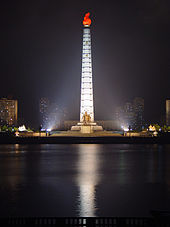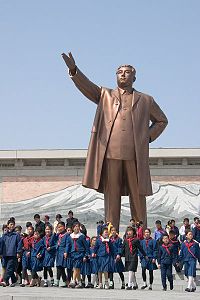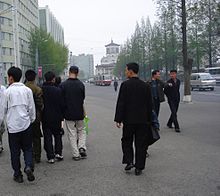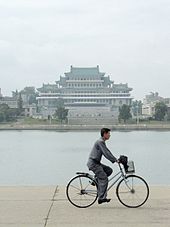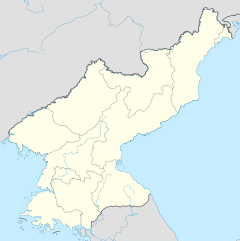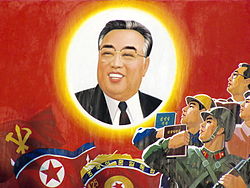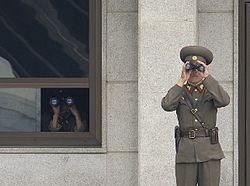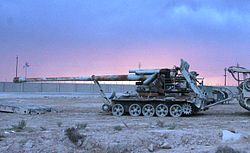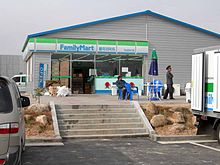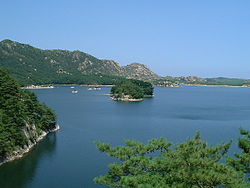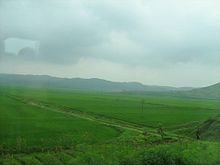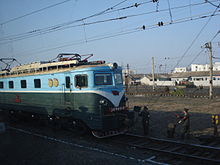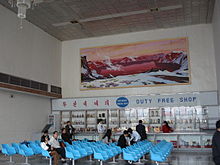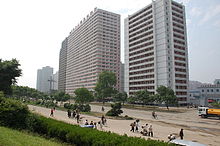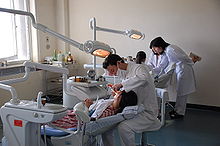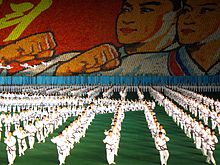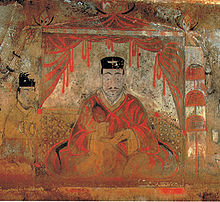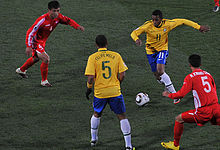
North Korea
Did you know...
SOS Children produced this website for schools as well as this video website about Africa. Sponsoring children helps children in the developing world to learn too.
Coordinates: 40°00′N 127°00′E
Democratic People's Republic of Korea
|
||||||
|---|---|---|---|---|---|---|
|
||||||
Motto:
|
||||||
Anthem:
|
||||||
|
|
||||||
| Capital and largest city |
Pyongyang 39°2′N 125°45′E |
|||||
| Official languages | Korean | |||||
| Official scripts | Chosŏn'gŭl | |||||
| Demonym |
|
|||||
| Government | Juche single-party Hereditary de facto totalitarian dictatorship |
|||||
| - | Eternal President | Kim Il-sung | ||||
| - | Eternal WPK General Secretary | Kim Jong-il | ||||
| - | Supreme Leader | Kim Jong-un | ||||
| - | Chairman of the Assembly Presidium |
Kim Yong-nam | ||||
| - | Premier | Pak Pong-ju | ||||
| Legislature | Supreme People's Assembly | |||||
| Establishment | ||||||
| - | Liberation | 15 August 1945 | ||||
| - | Formal declaration | 9 September 1948 | ||||
| Area | ||||||
| - | Total | 120,540 km2 ( 98th) 46,528 sq mi |
||||
| - | Water (%) | 4.87 | ||||
| Population | ||||||
| - | 2011 estimate | 24,554,000 ( 48th) | ||||
| - | 2011 census | 24,052,231 | ||||
| - | Density | 198.3/km2 513.8/sq mi |
||||
| GDP ( PPP) | 2011 estimate | |||||
| - | Total | $40 billion | ||||
| - | Per capita | $1,800 | ||||
| GDP (nominal) | 2011 estimate | |||||
| - | Total | $12.4 billion | ||||
| - | Per capita | $506 | ||||
| Gini (2007) | 31 medium · low |
|||||
| HDI (1995/1998) | 0.766 high · not ranked |
|||||
| Currency | North Korean won (₩) ( KPW) |
|||||
| Time zone | Korea Standard Time ( UTC+9) | |||||
| Date format |
|
|||||
| Drives on the | right | |||||
| Calling code | +850 | |||||
| ISO 3166 code | KP | |||||
| Internet TLD | .kp | |||||
| a. | ^ Kim Jong-un holds four concurrent positions: First Secretary of the Workers' Party, Chairman of the Central Military Commission, First Chairman of the National Defence Commission and Supreme Commander of the People's Army, serve as the "supreme leader" of the DPRK. | |||||
| b. | ^ Kim Yong-nam is the " head of state for foreign affairs". The position of president (formerly head of state) was written out of the constitution in 1998. Kim Il-sung, who died in 1994, was given the appellation " Eternal President" in its preamble. | |||||
The Democratic People's Republic of Korea (DPRK; Chosŏn'gŭl: 조선민주주의인민공화국; Chosŏn Minjujuŭi Inmin Konghwaguk), commonly called North Korea (![]() listen), is a country in East Asia, in the northern half of the Korean Peninsula. Its capital is Pyongyang, the country's largest city by both land area and population. The Amnok River and the Tumen River form the international border between North Korea and China. A small section of the Tumen River also lies along the border between North Korea and Russia, technically following the river's thalweg. The Korean Demilitarized Zone forms the boundary between North Korea and South Korea. The legitimacy of this border is not accepted by either side, as both states claim to be the legitimate government of the entire peninsula.
listen), is a country in East Asia, in the northern half of the Korean Peninsula. Its capital is Pyongyang, the country's largest city by both land area and population. The Amnok River and the Tumen River form the international border between North Korea and China. A small section of the Tumen River also lies along the border between North Korea and Russia, technically following the river's thalweg. The Korean Demilitarized Zone forms the boundary between North Korea and South Korea. The legitimacy of this border is not accepted by either side, as both states claim to be the legitimate government of the entire peninsula.
The Korean peninsula was governed by the Korean Empire from the late 19th century to the early 20th century, until it was annexed by the Empire of Japan in 1910. After the surrender of Japan at the end of World War II, Japanese rule ceased. The Korean peninsula was divided into two occupied zones in 1945, with the northern half of the peninsula occupied by the Soviet Union and the southern half by the United States. A United Nations–supervised election held in 1948 led to the creation of separate Korean governments for the two occupation zones: the Democratic People's Republic of Korea in the north, and the Republic of Korea in the south. The conflicting claims of sovereignty led to the Korean War in 1950. An armistice in 1953 committed both to a cease-fire, but the two countries remain officially at war because a formal peace treaty was never signed. Both states were accepted into the United Nations in 1991.
North Korea's political parties include the Workers' Party of Korea, the Korean Social Democratic Party and the Chondoist Chongu Party; there are also some independent deputies. The three political parties participate in the Democratic Front for the Reunification of the Fatherland led by the Workers' Party of Korea. The government follows the Juche ideology of self-reliance, initiated by the country's first President, Kim Il-sung. After his death, Kim Il-sung was declared the country's Eternal President. Juche became the official state ideology, replacing Marxism–Leninism, when the country adopted a new constitution in 1972. In 2009, references to Communism ( Chosŏn'gŭl: 공산주의) were removed from the country's constitution.
Education in North Korea is universal and state funded, with a national literacy rate of 99%. The country has a national medical service and claims to offer free healthcare. Conflicting accounts report that patients must pay. Many hospitals lack basic medicine, equipment, running water, and electricity due to economic problems and minimal budget allocation; at approximately 1 dollar per person per year, lower than that of most African countries. Housing and food rations traditionally have been heavily subsidized. The means of production are owned by the state through state-run enterprises and collectivized farms. Food output is one of the lowest worldwide, with the UN estimating 16 million people requiring food aid.
North Korean leader Kim Jong-Il adopted Songun, or "military-first" policy in order to strengthen the country and its government. North Korea is the world's most militarized country, with a total of 9,495,000 active, reserve, and paramilitary personnel. Its active duty army of 1.21 million is the 4th largest in the world, after China, the U.S., and India. It is a nuclear-weapons state and has an active space program.
With the dissolution of the Soviet Union in December 1991, North Korea lost a major trading partner and strategic ally. A combination of a series of heavy flooding and poor economic decisions led to the North Korean famine, which lasted from 1994 to 1998 and killed an estimated 240,000 to 1,000,000 people. As a result of its isolation it is sometimes known as the " Hermit kingdom", a name once given to its predecessor, the Korean Empire. Although North Korea is officially a socialist republic and elections are held, it has been described as a totalitarian and Stalinist dictatorship with an elaborate cult of personality around the Kim family. Also, the Economist Intelligence Unit, a private business based in the United Kingdom, ranked it as the lowest country in the Democracy Index. Finally, Amnesty International and Human Rights Watch report of severe restrictions on human rights but the government rejects these claims.
History
Ancient Kingdoms
According to legend, Gojoseon was the first Korean kingdom founded in the north of the peninsula in 2333 BC by Dangun. Gojoseon expanded until it controlled northern Korean Peninsula and some parts of Manchuria. Gojoseon was first mentioned in Chinese records in the early 7th century BC, and around the 4th century BC, its capital moved to Pyongyang.
After many conflicts with the Chinese Han Dynasty, Gojoseon disintegrated. A number of small states emerged in the 2nd–1st centuries BC, leading to the Proto–Three Kingdoms of Korea period. This saw the kingdoms of Buyeo, Okjeo, Dongye, and the Samhan confederacy occupying the peninsula and southern Manchuria. Of the various states, Goguryeo in the north, and Baekje and Silla in the south, grew to control the peninsula as the Three Kingdoms of Korea. Goguryeo was the first Korean kingdom to adopt Buddhism as the state religion in 372.
The kingdom reached its zenith in the 5th century AD, when it controlled central Korea, including the present-day Seoul area. Goguryeo fought numerous wars with China and repulsed a number of Chinese invasions. However, the kingdom fell into decline in the 7th century and after internal power struggles, it was conquered by allied Silla-Tang forces. The unification of the Three Kingdoms by Silla in 676 led to the North South States Period, in which much of the Korean Peninsula was controlled by Silla. The kingdom of Balhae controlled northern areas of Korea and parts of Manchuria between the 7th and 10th centuries.
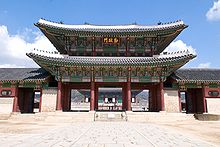
Under the rule of Unified Silla, relationships between Korea and China remained relatively peaceful. Silla weakened under internal strife, and eventually was defeated by Emperor Taejo of Goryeo of the Goryeo Dynasty in 935.
Goryeo, with its capital at Gaegyeong in present day North Korea, gradually came to rule the whole Korean peninsula. The Mongol invasions in the 13th century greatly weakened Goryeo. Goryeo became a dependency of the Mongol Empire and was forced to pay tribute. After the Mongol Empire collapsed, Korea experienced political strife and the Goryeo Dynasty was replaced in 1388 by the long-lasting Joseon Dynasty (named in honour of the ancient Gojoseon kingdom).
Middle Ages
The capital was moved south to Hanyang (modern-day Seoul) in 1394. Joseon accepted the nominal suzerainty of China. Internal conflicts within the royal court and civil unrest plagued the kingdom in the years that followed, a situation made worse by the depredations of Japanese pirates.
After a largely peaceful 15th century, central authority declined and Korea was plagued again by coastal raids by Japanese pirates. Two Japanese attempts to conquer Korea were repulsed in 1592–1598. In the early 17th century Korea became involved in wars against the rising Manchus on the northern borders.
The 17th–19th centuries were marked by increasing Joseon self-isolation from the outside world, dependence on China for external affairs and occasional internal faction fighting. The Joseon Dynasty tried to isolate from sea traders by closing itself to all nations except China. Slaves, nobi, are estimated to have accounted for about one third of the population of Joseon Korea. By the mid-19th century the Joseon court followed a cautious policy of slow exchange with the West. In 1866, an American-owned armed merchant ship, attempted to open Korea to trade. The ship sailed upriver and became stranded near Pyongyang.
After being ordered to leave by Korean officials, American crewmen killed four Korean inhabitants, kidnapped a military officer and engaged in sporadic fighting. The ship was finally set aflame by Korean fireships. In 1871, a US force killed 243 Korean troops on Ganghwa island. This incident is called the Sinmiyangyo in Korea. Five years later, the Korea signed a trade treaty with Japan, and in 1882 signed a treaty with the United States, ending centuries of isolationism of the " Hermit Kingdom".
Japanese occupation (1895–1945)
As a result of the Sino-Japanese War (1894–1895), the 1895 Treaty of Shimonoseki stipulated the end of traditional Joseon dependency on China. In 1897, Joseon was renamed the Korean Empire. Russian influence was strong until the Russo-Japanese War (1904–1905), after which Korea became a protectorate of Japan. Korea was then annexed by the Empire of Japan in 1910, leading to 35 years of military rule.
After the annexation, Japan tried to suppress Korean traditions and culture and ran the economy primarily for the Japanese benefit. Anti-Japanese, pro-liberation rallies took place nationwide on 1 March 1919 (the 1 March Movement). About 7,000 people were killed during the suppression of this movement. Continued anti-Japanese uprisings, such as the nationwide uprising of students in 1929, led to the strengthening of military rule in 1931. After the outbreaks of the Sino-Japanese War in 1937 and World War II Japan stepped up efforts to extinguish Korean culture.
The Korean language was banned and Koreans were forced to adopt Japanese names. Worship at Japanese Shinto shrines was made compulsory. The school curriculum was radically modified to eliminate teaching in the Korean language and history. Numerous Korean cultural artifacts were destroyed or taken to Japan. Resistance groups known as Dongnipgun (Liberation Army) operated along the Sino-Korean border, fighting guerrilla warfare against Japanese forces. Some of them took part in allied action in China and parts of South East Asia.
During World War II, Koreans at home were forced to support the Japanese war effort. Tens of thousands of men were conscripted into Japan's military. Around 200,000 girls and women, many from Korea, were forced to engage in sexual services, with the euphemism " comfort women".
Division of Korea (1945)
After the surrender of Japan at the end of World War II, Japanese rule was brought to an end. The Korean peninsula was divided into two occupied zones in 1945 along the 38th parallel, with the northern half of the peninsula occupied by the Soviet Union and the southern half by the United States, in accordance with a prior arrangement between the two world powers, where United Nations–supervised elections were intended to be held for the entire peninsula shortly after the war. The Provisional Government of the Republic of Korea, which had operated in exile since 1919, was ignored, mainly because of the American perception that it was too communist-aligned.
In August 1945, the Soviet Army established a Soviet Civil Authority in the northern portion of the Korean Peninsula. The Provisional People's Committee for North Korea was set up in February 1946, headed by Kim Il-sung. He introduced sweeping land reforms and nationalized key industries. Talks on the future of Korea were held in Moscow and Seoul but without result. Initial hopes for a unified, independent Korea evaporated as the politics of the Cold War resulted in the establishment of two separate nations with diametrically opposed political, economic, and social systems.
There was sporadic unrest in the South. In September 1946, South Korean citizens had risen up against the Allied Military Government. In April 1948, an uprising of the Jeju islanders was violently crushed. The South declared its statehood in May 1948 and two months later the ardent anti-Communist Syngman Rhee became its ruler. The People's Republic of Korea was established in the North on 9 September 1948.
The Rhee regime consolidated itself through harsh persecution of all suspected opponents. It conducted a number of military campaigns against left-wing insurgents during which 30,000 to 100,000 people lost their lives. In October 1948, the Yeosu-Suncheon Rebellion occurred and on 24 December 1949, the South Korean Army massacred Mungyeong citizens who were suspected communist sympathizers and affixed the blame on communists.
Soviet forces withdrew from the North in 1948 and most American forces withdrew from the South the following year. This dramatically weakened the Southern regime and encouraged Kim Il-sung to consider an invasion plan against the South. War proposals were rejected several times by Joseph Stalin, but along with the development of Soviet nuclear weapons, Mao Zedong's victory in China, and the Chinese indication that it would send troops and other support to North Korea, Stalin approved the invasion which led to the start of the Korean War in June 1950. The Korean War broke out when North Korean forces crossed the 38th parallel to invade the South.
Korean War (1950–1953)
After Korea was divided by the UN, the two Korean powers both tried to control the whole peninsula under their respective governments. This led to escalating border conflicts on the 38th parallel and attempts to negotiate elections for the whole of Korea. These attempts ended when the military of North Korea invaded the South on 25 June 1950, leading to a full-scale civil war. With endorsement from the United Nations, countries allied with the United States intervened on behalf of South Korea.
After rapid advances in a South Korean counterattack, North-allied Chinese forces intervened on behalf of North Korea, shifting the balance of the war. Fighting ended on 27 July 1953, with an armistice that approximately restored the original boundaries between North and South Korea. More than one million civilians and soldiers were killed in the war.
Although some have referred to the conflict as a civil war, other important factors were involved. The Korean War was also the first armed confrontation of the Cold War and set the standard for many later conflicts. It is often viewed as an example of the proxy war, where the two superpowers would fight in another country, forcing the people in that country to suffer most of the destruction and death involved in a war between such large nations. The superpowers avoided descending into an all-out war against one another, as well as the mutual use of nuclear weapons. It also expanded the Cold War, which to that point had mostly been concerned with Europe. A heavily guarded demilitarized zone on the 38th parallel still divides the peninsula, and an anti-Communist and anti-North Korea sentiment remains in South Korea.
Since the Armistice in 1953, relations between the North Korean government and South Korea, the European Union, Canada, the United States, and Japan have remained tense, and hostile incidents occur often. North and South Korea signed the June 15th North-South Joint Declaration in 2000, in which they promised to seek peaceful reunification. On 4 October 2007, the leaders of North and South Korea pledged to hold summit talks to officially declare the war over and reaffirmed the principle of mutual non-aggression. On 13 March 2013, North Korea confirmed it ended the 1953 Armistice and declared North Korea "is not restrained by the North-South declaration on non-aggression."
Late 20th century
The relative peace between the south and the north following the armistice was interrupted by border skirmishes and assassination attempts. The North failed in several assassination attempts on South Korean leaders, most notably in 1968, 1974 and the Rangoon bombing in 1983; tunnels were frequently found under the DMZ and war nearly broke out over the Axe Murder Incident at Panmunjeom in 1976. In 1973, extremely secret, high-level contacts began to be conducted through the offices of the Red Cross, but ended after the Panmunjeom incident with little progress having been made and the idea that the two Koreas would join international organizations separately.
North Korea remained closely aligned to China and the Soviet Union until the mid-1960s. Recovery from the war was quick – by 1957 industrial production reached 1949 levels. Until the 1960s, economic growth was higher than in South Korea, and North Korean GDP per capita was equal to that of its southern neighbour as late as 1976. The last Chinese troops withdrew from the country in October 1958.
In the late 1990s, with the South having transitioned to liberal democracy, the success of the Nordpolitik policy, and power in the North having been taken up by Kim Il-sung's son Kim Jong-il, the two nations began to engage publicly for the first time, with the South declaring its Sunshine Policy.
Early 21st century
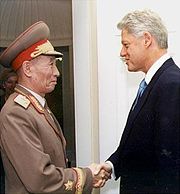
In January 2002, U.S. president George W. Bush labeled North Korea part of an " axis of evil" and an " outpost of tyranny". The highest-level contact the government has had with the United States was with U.S. Secretary of State Madeleine Albright, who made a visit to Pyongyang in 2000, but the two countries do not have formal diplomatic relations. By 2006, approximately 37,000 American soldiers remained in South Korea, although by June 2009 this number had fallen to around 30,000. Kim Jong-il privately stated his acceptance of U.S. troops on the peninsula, even after a possible reunification. Publicly, North Korea strongly demands the removal of American troops from South Korea.
On 13 June 2009, the Associated Press reported that in response to new U.N. sanctions, North Korea declared it would progress with its uranium enrichment program. This marked the first time the DPRK has publicly acknowledged that it is conducting a uranium enrichment program. In August 2009, former U.S. president Bill Clinton met with Kim Jong-il to secure the release of two American journalists, who had been sentenced for entering the country illegally. Current U.S. President Barack Obama's position towards North Korea has been to resist making deals with North Korea for the sake of defusing tension, a policy known as "strategic patience."
On 23 November 2010, North Korea fired about 170 rounds of artillery on Yeonpyeong Island and the surrounding waters near the Yellow Sea border, with some 90 shells landing on the island. The attack resulted in the deaths of two marines and two civilians on the South Korean side, and fifteen marines and at least three civilians wounded. South Korean forces fired back 80 shells, although the results remain unclear. North Korean news sources alleged that the North Korean actions, described as "a prompt and powerful physical strike", were in response to provocation from South Korea that had held an artillery exercise in the disputed waters south of the island.
On 17 December 2011, the Supreme Leader of North Korea, Kim Jong-il died from a heart attack. His death was reported by the Korean Central News Agency around 08:30 local time with the newscaster announcing his youngest son Kim Jong-un as his successor.
The announcement placed South Korean and United States troops on high alert, with many politicians from the global community stating that Kim's death leaves a great deal of uncertainty in the country's future. North Korea was put into a state of semi-alert, with foreigners put under suspicion and asked to leave.
Pre-emptive nuclear strike threats of 2013
On 7 March 2013, North Korea announced its intentions to launch a preemptive nuclear strike against the United States. The statement called the United States, the "sworn enemy of the Korean people".
On 8 March 2013, the North Korean government announced that it was withdrawing from all non-aggression pacts with South Korea in response to U.N. Resolution 2094. The announcement said it was closing its joint border crossing with South Korea and cutting off the hotline to the South.
On 13 March 2013, North Korea confirmed it ended the 1953 Armistice and declared North Korea "is not restrained by the North-South declaration on non-aggression. Confirmation of the severing of the hotline between the North and the South—the last remaining communication link between the two countries at that time—was publicly announced on March 27, 2013, the same date that the hotline was cut off. According to the Korean Central News Agency, a senior North Korean military official stated: "Under the situation where a war may break out any moment, there is no need to keep up North-South military communications" prior to the cessation of the communication channel.
On 30 March 2013, the North Korean government declared it was in 'a state of war' with South Korea. A North Korean statement promised "stern physical actions" against "any provocative act". The North Korean leader Kim Jong-un declared that rockets were ready to be fired at American bases in the Pacific in response to the U.S. flying two nuclear-capable B2 stealth bombers over the Korean peninsula. The United States warned North Korea that the rapidly escalating military confrontation would lead to further isolation, as The Pentagon declared that the U.S. was "fully capable" of defending itself and its allies against a missile attack. On 4 April 2013 North Korea's state news agency KCNA announced "The moment of explosion is approaching fast. No one can say a war will break out in Korea or not and whether it will break out today or tomorrow."
U.S. National Intelligence Director James Clapper speculated that Kim Jong-un is trying to assert his control over North Korea, and has no endgame other than gaining recognition; analysts and other U.S. officials have echoed similar sentiments.
Four missiles launches were fired on May 18 and 19, 2013—according to South Korea's defense ministry, short-range guided three missiles landed into the waters off the Korean peninsula on May 18, followed by a fourth on May 19. The missiles did not place neighboring nations in a risky situation and Pyongyang's actions were widely viewed as an exercise in fear creation to prompt other countries to consider security and aid concessions. The launches occurred during a period when relations were strained between the North and the South, as Pyongyang refused to participate in talks over the closed Kaesong plant.
At the start of June 2013, the North Korean government delivered a proposal to its southern counterpart, whereby it offered to enter into talks that would represent the first dialogue of its kind in many years. The South Korean government immediately accepted the proposal.
Geography
North Korea occupies the northern portion of the Korean Peninsula, lying between latitudes 37° and 43°N, and longitudes 124° and 131°E. It covers an area of 120,540 square kilometres (46,541 sq mi). North Korea shares land borders with China and Russia to the north, and borders South Korea along the Korean Demilitarized Zone.
To its west are the Yellow Sea and Korea Bay, and to its east lies Japan across the Sea of Japan (East Sea of Korea). The highest point in North Korea is Baekdu Mountain at 2,744 metres (9,003 ft). The longest river is the Amnok River which flows for 790 kilometres (491 mi). The capital and largest city is Pyongyang; other major cities include Kaesong in the south, Sinuiju in the northwest, Wonsan and Hamhung in the east and Chongjin in the northeast.
In 2013, internet users were encouraged to participate in a community based event on Google Maps. These users could use Google Map Maker along with Cartography and Telemetry skills that eventually led to a virtual map of Pyongyang. In addition, the Google Map of North Korea includes political prison camp locations such as Camp 22.
Topography
Early European visitors to Korea remarked that the country resembled "a sea in a heavy gale" because of the many successive mountain ranges that crisscross the peninsula. Some 80% of North Korea is composed of mountains and uplands, separated by deep and narrow valleys, with all of the peninsula's mountains with elevations of 2,000 metres (6,600 ft) or more located in North Korea. The coastal plains are wide in the west and discontinuous in the east. A great majority of the population lives in the plains and lowlands.
The highest point in North Korea is Baekdu Mountain which is a volcanic mountain near the Chinese border with basalt lava plateau with elevations between 1,400 and 2,744 metres (4,600 and 9,003 ft) above sea level. The Hamgyong Range, located in the extreme northeastern part of the peninsula, has many high peaks including Gwanmosan at approximately 1,756 m (5,761 ft).
Other major ranges include the Rangrim Mountains, which are located in the north-central part of North Korea and run in a north-south direction, making communication between the eastern and western parts of the country rather difficult; and the Kangnam Range, which runs along the North Korea–China border. Mount Kumgang, or Diamond Mountain, (approximately 1,638 metres or 5,374 feet) in the Taebaek Range, which extends into South Korea, is famous for its scenic beauty.
For the most part, the plains are small. The most extensive are the Pyongyang and Chaeryong plains, each covering about 500 square kilometres (190 sq mi). Because the mountains on the east coast drop abruptly to the sea, the plains are even smaller there than on the west coast. Unlike neighboring Japan or northern China, North Korea experiences few severe earthquakes.
Climate
North Korea has a continental climate with four distinct seasons. Long winters bring bitter cold and clear weather interspersed with snow storms as a result of northern and northwestern winds that blow from Siberia. Average snowfall is 37 days during the winter. The weather is likely to be particularly harsh in the northern, mountainous regions.
Summer tends to be short, hot, humid, and rainy because of the southern and southeastern monsoon winds that bring moist air from the Pacific Ocean. Typhoons affect the peninsula on an average of at least once every summer. Spring and autumn are transitional seasons marked by mild temperatures and variable winds and bring the most pleasant weather. Natural hazards include late spring droughts which often are followed by severe flooding. There are occasional typhoons during the early fall.
North Korea's climate is relatively temperate. Most of the country is classified as type Dwa in the Köppen climate classification scheme, with warm summers and cold, dry winters. In summer there is a short rainy season called changma. On 7 August 2007, the most devastating floods in 40 years caused the North Korean government to ask for international help. NGOs, such as the Red Cross, asked people to raise funds because they feared a humanitarian catastrophe.
Administrative divisions
| Map | Namea | Chosŏn'gŭl | Administrative Seat | ||
|---|---|---|---|---|---|
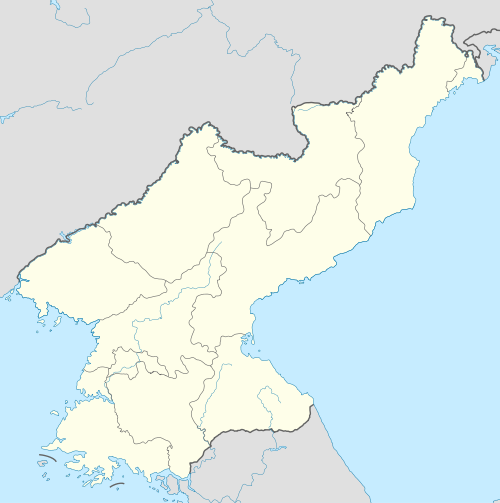 Rason
Nampo
South Pyongan
North Hwanghae
South Hwanghae
Kangwon
South Hamgyong
North Hamgyong
Ryanggang
Chagang
North Pyongan
Yellow Sea
(Korea West Sea) Korea Bay
Sea of Japan
(Korea East Sea) |
Capital city (chikhalsi)a | ||||
| 1 | Pyongyang | 평양직할시 | ( Chung-guyok) | ||
| Special city (teukbyeolsi)a | |||||
| 2 | Rason | 라선특별시 | ( Rajin-guyok) | ||
| Provinces (do)a | |||||
| 3 | South Pyongan | 평안남도 | Pyongsong | ||
| 4 | North Pyongan | 평안북도 | Sinuiju | ||
| 5 | Chagang | 자강도 | Kanggye | ||
| 6 | South Hwanghae | 황해남도 | Haeju | ||
| 7 | North Hwanghae | 황해북도 | Sariwon | ||
| 8 | Kangwon | 강원도 | Wonsan | ||
| 9 | South Hamgyong | 함경남도 | Hamhung | ||
| 10 | North Hamgyong | 함경북도 | Chongjin | ||
| 11 | Ryanggang * | 량강도 | Hyesan | ||
| * – Rendered in Southern dialects as "Yanggang" (양강도). | |||||
| Largest cities or towns of North Korea 2008 Census |
|||||||||
|---|---|---|---|---|---|---|---|---|---|
| Rank | City name | Administrative division | Pop. | ||||||
 Pyongyang |
1 | Pyongyang | Pyongyang Capital City | 3,255,288 |  Chongjin |
||||
| 2 | Hamhung | South Hamgyong Province | 768,551 | ||||||
| 3 | Chongjin | North Hamgyong Province | 667,929 | ||||||
| 4 | Nampho | South Pyongan Province | 366,815 | ||||||
| 5 | Wonsan | Kangwon Province | 363,127 | ||||||
| 6 | Sinuiju | North Pyongan Province | 359,341 | ||||||
| 7 | Tanchon | South Hamgyong Province | 345,875 | ||||||
| 8 | Kaechon | South Pyongan Province | 319,554 | ||||||
| 9 | Kaesong | North Hwanghae Province | 308,440 | ||||||
| 10 | Sariwon | North Hwanghae Province | 307,764 | ||||||
Government and politics
Regime ideology
North Korea is a self-described Juche (self-reliant) state, described by some observers as a de facto absolute monarchy or "hereditary dictatorship" with a pronounced cult of personality organized around Kim Il-sung (the founder of North Korea and the country's only president) and his late son, Kim Jong-il. North Korea uses a government system that also utilizes a Departmentalization system of Ministries. There are also those who reject the view that North Korea is a socialist state espousing communism, instead claiming that the North Korean leadership uses Stalinist communism as a justification for their rule.
More recent research based on North Korea’s domestic documents and not propaganda for the international audience, popularized in 2009 by Brian R. Myers and his book The Cleanest Race and later supported by further academics characterizes North Korean ideology as being a racialist focused nationalism, and heavily influenced by the racialist outlook of Japan before the end of the Second World War.
Myers is dismissive of the idea that juche is North Korea's leading ideology, regarding its public exaltation as designed to deceive foreigners. Myers points out that North Korea's latest constitution, of 2009, omits all mention of communism. Charles K. Armstrong criticizes Myers for taking the Japanese comparison too far, suggesting that North Korean ideology is "actually closer to European fascism" than to Imperial Japanese fascism, since Imperial Japan lacked a charismatic leader and mass-mobilizing party.
Leadership
Following Kim Il-sung's death in 1994, he was not replaced but instead received the designation of " Eternal President", and was entombed in the vast Kumsusan Palace of the Sun in central Pyongyang.
Although the office of the President is ceremonially held by the deceased Kim Il-sung, the Supreme Leader until his death in December 2011 was Kim Jong-il, who was General Secretary of the Workers' Party of Korea and Chairman of the National Defence Commission of North Korea. The legislature of North Korea is the Supreme People's Assembly, currently led by Chairman Kim Yong-nam. The head of the Cabinet of North Korea is the Premier of North Korea Pak Pong-ju.
The structure of the government is described in the Constitution of North Korea, the latest version of which is from 2009 and officially rejects North Korea's founding ideology of communism. The governing party by law is the Democratic Front for the Reunification of the Fatherland, a coalition of the Workers' Party of Korea and two other smaller parties, the Korean Social Democratic Party and the Chondoist Chongu Party. These parties nominate all candidates for office and hold all seats in the Supreme People's Assembly. They have negligible power, as the leader holds autocratic control over the nation's affairs.
In June 2009, it was reported in South Korean media that intelligence indicated that the country's next leader would be Kim Jong-un, the youngest of Kim Jong-il's three sons. This was confirmed on 19 December 2011, following Kim Jong-il's death. According to Cheong Seong-chang of Sejong Institute, speaking on 25 June 2012, there is some possibility that the new leader Kim Jong-un, who has greater visible interest in the welfare of his people and engages in greater interaction with them than his father did, will consider economic reforms and regularization of international relations.
Controls on political expression
Political expression is tightly controlled in North Korea. Supporters of the government who deviate from the government line are subject to reeducation in sections of labor camps set aside for that purpose. Those who are successfully rehabilitated may reassume responsible government positions on their release.
Troublesome political dissidents, factionalists and class enemies, who are considered irredeemable are incarcerated together with any close family members or children born in the camp in " Total Control Zones" for a life of hard labor. Labor camps in North Korea are actually areas of the country set aside for that purpose, Camp 22 (also known as Kwan-li-so No.22 Haengyong) is 31 miles by 25 miles with a population of about 50,000. Those who attempt to escape or violate camp rules are executed or sent to a separate prison within the camp. The labor camps are reserved for political prisoners; common criminals are incarcerated in a separate system. There are 6 such areas in the northern and northeastern portion of North Korea.
Foreign relations
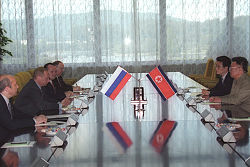
North Korea has long maintained close relations with the People's Republic of China (PRC) and Russia. The fall of communism in eastern Europe in 1989, and the disintegration of the Soviet Union in 1991, resulted in a devastating drop in aid to North Korea from Russia, although China continues to provide substantial assistance. North Korea continues to have strong ties with its socialist southeast Asian allies in Vietnam and Laos, as well as with Cambodia. North Korea has started installing a concrete and barbed wire fence on its northern border, in response to China's wish to curb an overflow of illegal refugees from North Korea. Previously, the border between China and North Korea had only been lightly patrolled.
As a result of the North Korean nuclear weapons program, the six-party talks were established to find a peaceful solution to the growing tension between the two Korean governments, the Russian Federation, the People's Republic of China, Japan, and the United States.
On 17 July 2007, United Nations inspectors verified the shutdown of five North Korean nuclear facilities, according to the February 2007 agreement. On 4 October 2007, South Korean President Roh Moo-Hyun and North Korean leader Kim Jong-il signed an 8-point peace agreement, on issues of permanent peace, high-level talks, economic cooperation, renewal of train, highway and air travel, and a joint Olympic cheering squad.
The United States and South Korea previously designated the North as a state sponsor of terrorism. The 1983 bombing that killed members of the South Korean government and the destruction of a South Korean airliner have been attributed to North Korea. North Korea has also admitted responsibility for the kidnapping of 13 Japanese citizens in the 1970s and 1980s, five of whom were returned to Japan in 2002. On 11 October 2008, the United States removed North Korea from its list of states that sponsor terrorism.
In 2009, relationships between North and South Korea increased in intensity; North Korea had been reported to have deployed missiles, ended its former agreements with South Korea, and threatened South Korea and the United States not to interfere with a satellite launch it had planned. North and South Korea are still technically at war (having never signed a peace treaty after the Korean War) and share the world’s most heavily fortified border. On 27 May 2009, North Korean media declared that the Korean Armistice was no longer valid because the South Korean government's pledge to "definitely join" the Proliferation Security Initiative.
To further complicate and intensify strain between the two nations, the sinking of the South Korean warship Cheonan in March 2010, killing 46 seamen, is as of 20 May 2010 claimed by a multi-national research team to have been caused by a North Korean torpedo, which the North denies. South Korea agreed with the findings from the research group and President Lee Myung-bak declared in May 2010 that Seoul would cut all trade with North Korea as part of measures primarily aimed at striking back at North Korea diplomatically and financially. As a result of this, North Korea severed all ties, completely abrogated the previous pact of non aggression and expelled all South Koreans from a joint industrial zone in Kaesong. On 23 November 2010, North Korea attacked Yeonpyeong Island, further deteriorating the diplomatic relations with the South and other nations.
Most of the foreign embassies connecting with diplomatic ties to North Korea are located in Beijing (Capital of China) rather than in Pyongyang (Capital of DPRK).
Society
Ascribed status
According to North Korean documents and refugee testimonies, all North Koreans are sorted into groups according to their Songbun, an ascribed status system. Based on their own behavior and the political, social, and economic background of their family for three generations as well as behaviour by relatives within that range, Songbun is allegedly used to determine whether an individual is trusted with responsibility, given opportunities, or even receives adequate food.
Songbun allegedly affects access to educational and employment opportunities and particularly whether a person is eligible to join North Korea's ruling party. There are 3 main classifications and about 50 sub-classifications. According to Kim Il-sung, speaking in 1958, the loyal "core class" constituted 25% of the North Korean population, the "wavering class" 55%, and the "hostile class" 20%. The highest status is accorded to individuals descended from those who participated with Kim Il-sung in the resistance against Japanese occupation during and before World War II and to those who were factory workers, laborers or peasants as of 1950.
While some analysts believe private commerce recently changed the Songbun system to some extent, most North Korean refugees say it remains a commanding presence in everyday life. However the North Korean government claims all citizens are equal and denies any discrimination on the basis of family background.
Human rights
Many international human rights organizations accuse North Korea of having one of the worst human rights records of any nation. Amnesty International reports of severe restrictions on the freedom of association, expression and movement, arbitrary detention, torture and other ill-treatment resulting in death, and executions. The organization demands the closure of prison camps, where 200,000 political prisoners and their families exist in “the most inhuman conditions imaginable”. North Koreans have been referred to as "some of the world's most brutalized people" by Human Rights Watch, because of the severe restrictions placed on their political and economic freedoms.
In the 1990s just listening to South Korean radio could result in capital punishment. Some were also allegedly sent to prison camps for singing a South Korean song.
Political prison camps
The State Security Department of North Korea is responsible for several activities involving law enforcement and allegedly maintain various prison camps. North Korean defectors have testified to the existence of prisons and concentration camps including " total control zones", (Kwan-li-so : 관리소), where political undesirables are imprisoned for life at hard labor and are subjected to reported torture, starvation, rape, murder, medical experimentation, forced labor, and forced abortions.
According to Amnesty International, based on satellite images and testimonies, around 200,000 prisoners (about 0.85% of the population) are held in six large political prison camps, being in operation since the 1950s. They are forced to work in conditions approaching slavery and are frequently subjected to torture and other cruel, inhumane, and degrading treatment. Camp 14 in Kaechon, Camp 15 in Yodok and Camp 18 in Bukchang are described in detailed testimonies.
People suspected of not being loyal to the regime, e.g. because they are Christians or because they criticized the leadership, are deported to these camps without trial, often with their whole family and mostly without any chance of being released. The International Coalition to Stop Crimes Against Humanity in North Korea (ICNK) estimates that over 10,000 people die in North Korean prison camps every year. According to R.J. Rummel, forced labor, executions, and concentration camps were responsible for over one million deaths in North Korea from 1948 to 1987; others have estimated 400,000 deaths in concentration camps alone.
Personality cult
The North Korean government exercises control over many aspects of the nation's culture, and this control is used to perpetuate a cult of personality surrounding Kim Il-sung, and, to a lesser extent, Kim Jong-il. While visiting North Korea in 1979, journalist Bradley Martin noted that nearly all music, art, and sculpture that he observed glorified "Great Leader" Kim Il-sung, whose personality cult was then being extended to his son, "Dear Leader" Kim Jong-il. Bradley Martin also reported that there is even widespread belief that Kim Il-sung "created the world", and Kim Jong-il could "control the weather".
Such reports are contested by North Korea researcher Brian R. Myers: "divine powers have never been attributed to either of the two Kims. In fact, the propaganda apparatus in Pyongyang has generally been careful not to make claims that run directly counter to citizens’ experience or common sense." He further explains that the state propaganda painted Kim Jong-il as someone whose expertise lay in military matters and that the famine of the 1990s was partially caused by natural disasters out of Kim Jong-il's control.
The song " No Motherland Without You" (당신이없으면 조국도없다), sung by the North Korean Army Choir, was created especially for Kim Jong-il and is one of the most popular tunes in the country. Kim Il-sung is still officially revered as the nation's "Eternal President". Several landmarks in North Korea are named for Kim Il-sung, including Kim Il-sung University, Kim Il-sung Stadium, and Kim Il-sung Square. Defectors have been quoted as saying that North Korean schools deify both father and son. Kim Il-sung rejected the notion that he had created a cult around himself, and accused those who suggested this of " factionalism". Following the death of Kim Il-Sung, North Koreans were prostrating and weeping to a bronze statue of him in an organized event; similar scenes were broadcast by state television following the death of Kim Jong-il.
Critics maintain this Kim Jong-il personality cult was inherited from his father, Kim Il-sung. Kim Jong-il was often the centre of attention throughout ordinary life in the DPRK. His birthday is one of the most important public holidays in the country. On his 60th birthday (based on his official date of birth), mass celebrations occurred throughout the country. Kim Jong-il's personality cult, although significant, was not as extensive as his father's. One point of view is that Kim Jong-il's cult of personality was solely out of respect for Kim Il-sung or out of fear of punishment for failure to pay homage. Media and government sources from outside of North Korea generally support this view, while North Korean government sources say that it is genuine hero worship.
B.R. Myers also argues that the worship is real and not unlike worship of Adolf Hitler in Nazi Germany. In a more recent event – on 11 June 2012 – a 14-year-old North Korean schoolgirl drowned while attempting to rescue portraits of Kim Il-sung and Kim Jong-il from a flood.
Korean reunification
North Korea's policy is to seek reunification without what it sees as outside interference, through a federal structure retaining each side's leadership and systems. In 2000, both North and South Korea signed the June 15th North–South Joint Declaration in which both sides made promises to seek out a peaceful reunification. The Democratic Federal Republic of Korea is a proposed state first mentioned by then North Korean president Kim Il-sung on 10 October 1980, proposing a federation between North and South Korea in which the respective political systems would initially remain.
Military
The Ministry of the People's Armed Forces maintains the Korean People's Army (KPA), which serves as the military force of the country. The Korean People's Army (KPA) is the name for the collective armed personnel of the North Korean military. It has five branches: Ground Force, Naval Force, Air Force, Special Operations Force, and Rocket Force. According to the U.S. Department of State, North Korea has the fourth-largest army in the world, at an estimated 1.21 million armed personnel, with about 20% of men aged 17–54 in the regular armed forces. North Korea has the highest percentage of military personnel per capita of any nation in the world, with approximately one enlisted soldier for every 25 citizens. North Korea also has a Defense Industry that is responsible for engineering military equipment. In 1994, North Korea received 10 Golf II Class Submarines from Russia.
Military strategy is designed for insertion of agents and sabotage behind enemy lines in wartime, with much of the KPA's forces deployed along the heavily fortified Korean Demilitarized Zone. The Korean People's Army operates a very large amount of equipment, including 4,060 tanks, 2,500 APCs, 17,900 artillery pieces, 11,000 air defense guns and some 10,000 MANPADS and anti-tank guided missiles in the Ground force; at least 915 vessels in the Navy and 1,748 aircraft in the Air Force, of which 478 are fighters and 180 are bombers.
North Korea also has the largest special forces in the world, as well as the largest submarine fleet. The equipment is a mixture of World War II vintage vehicles and small arms, widely proliferated Cold War technology, and more modern Soviet or locally produced weapons. In line with its asymmetric warfare strategy, North Korea employs a wide range of unconventional techniques and equipment, such as GPS jammers, stealth paint, midget submarines and human torpedoes, a vast array of chemical and biological weapons, and blinding laser weapons. According to official North Korean media, military expenditures for 2010 amount to 15.8% of the state budget.
North Korea has active nuclear and ballistic missile weapons programs and has been subject to United Nations Security Council resolutions 1695 of July 2006, 1718 of October 2006, and 1874 of June 2009, for carrying out both missile and nuclear tests. North Korea probably has fissile material for up to nine nuclear weapons, and has the capability to deploy nuclear warheads on intermediate-range ballistic missiles. The launch of a North Korean satellite in December 2012 was seen as a weapons development step by South Korea and its allies and condemned by the UN Security Council.
Weapons Manufacturing
In North Korea, weapons are manufactured in roughly 180 underground defense industry plants in Jagang-do. The plants are responsible for producing; 200,000 Kalashnikov rifles annually, 3,000 heavy guns, 200 battle tanks, 400 armored cars and amphibious crafts in addition to several other weapons.
Nuclear capabilities
In the 1990s, North Korea sold medium-sized nuclear capable missiles to Pakistan in a deal facilitated by China. In 2005, North Korea admitted to having nuclear weapons but vowed to close their nuclear programs. The promise of a reduction in nuclear programs has also been reinforced at various Inter-Korean Summit meetings between North and South Korea since the year 2000. However, nuclear plants in North Korea have caused international concern since the 1950s as they are capable of assisting in the development of nuclear arms. International issues involving North Korea's refusal to discontinue nuclear projects have prevented Russia based Gazprom from developing a $2.5 billion pipeline to South Korea through Pyongyang. The revenue generated from Gazprom is intended to provide North Korea with $100 million per year in transit fees.
The Japan Meteorological Agency has been able to use technological advances in seismology to detect various nuclear weapons tests.
Economy
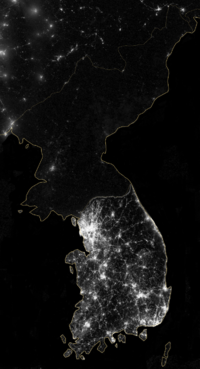
The economy of North Korea operates under the Central Bank of the Democratic People's Republic of Korea and issues the North Korean won. North Korea has an industrialized, near- autarkic, highly centralized command economy. North Korea and Cuba are the only two states with an almost entirely government-planned, state-owned economy. The Central Planning Committee prepares, supervises and implements economic plans, while a General Bureau of Provincial Industry in each region is responsible for the management of local manufacturing facilities, production, resource allocation, and sales.
North Korea's isolation policy means that international trade is highly restricted. North Korea passed a law in 1984 allowing for foreign investment through joint ventures, but failed to attract any significant investment. In 1991, it established the Rason Economic Special Zone, in an attempt to attract foreign investment from China and Russia. Chinese and Russian companies have purchased rights to use the ports at Rason. Chinese investors are renovating a road from Rason to China, and Russian railway workers are renovating the railway from Rason to Russia, from where it continues onto the Trans-Siberian Railway.
Until 1998, the United Nations published HDI and GDP per capita figures for North Korea, which stood at a medium level of human development at 0.766 (ranked 75th) and a GDP per capita of $4,058. The average salary was about $47 per month in 2004. The average official salary in 2011 was equivalent to $2 per month while the actual monthly income seems to be around $15 because most North Koreans earn money in illegal small businesses: trade, subsistence farming, and handicrafts. The illegal economy is dominated by women because men have to attend their places of official work even though most of the factories are non-functioning. It is estimated that in the early 2000s, the average North Korean family drew some 80% of its income from small businesses that are legal in market economies but illegal in North Korea.
Despite substantial economic problems, quality of life was improving and wages were rising steadily in 2007. Small-scale private markets, known as janmadang, exist throughout the country and provide the population with imported food and commodities ranging from cosmetics to motorcycles in exchange for money. In 2009, the government carried out a currency redenomination with the aim to curb free market activity across the country, but the attempt failed, causing inflation rates to skyrocket, and eventually led to the lifting of the ban on free market trade.
Food rations, housing, healthcare, and education are offered from the state for free, and the payment of taxes has been abolished since 1 April 1974. In order to increase productivity from agriculture and industry, since the 1960s the North Korean government has introduced a number of management systems such as the Taean work system. In the 21st century, following a recovery in 1999, North Korea's GDP growth was slow but steady until 2005. Between 2006 and 2011 the majority of years have had negative growth. In 2012 the Bank of Korea published the following estimates of North Korea's GDP growth:
| 2000 | 2001 | 2002 | 2003 | 2004 | 2005 | 2006 | 2007 | 2008 | 2009 | 2010 | 2011 |
|---|---|---|---|---|---|---|---|---|---|---|---|
| 0.3% | 3.8% | 1.2% | 1.8% | 2.1% | 3.8% | −1.0% | −1.2% | 3.1% | −0.9% | −0.5% | 0.8% |
According to estimates from 2002, the dominant sector in the North Korean economy is industry (43.1%), followed by services (33.6%) and agriculture (23.3%). In 2004, it was estimated that agriculture employed 37% of the workforce while industry and services employed the remaining 63%. Major industries include military products, machine building, electric power, chemicals, mining, metallurgy, textiles, food processing and tourism. Iron ore and coal production are among the few sectors where North Korea performs significantly better than its southern neighbour – the DPRK produces about 10 times larger amounts of each resource. In the agricultural sector, Potato production in North Korea is a major activity that provides for food security in the country.
Rice yields are about 2.8 tons per hectare, about half that in most countries, with soil degradation, lack of fertilizers, and limited mechanization blamed. In 2005, North Korea was ranked by the FAO as an estimated 10th in the production of fresh fruit and as an estimated 19th in the production of apples. It has substantial natural resources and is the world's 18th largest producer of iron and zinc, having the 22nd largest coal reserves in the world. It is also the 15th largest fluorite producer and 12th largest producer of copper and salt in Asia. Other major natural resources in production include lead, tungsten, graphite, magnesite, gold, pyrites, fluorspar, and hydropower.
Private commerce
In 1991, North Korea started experimenting with private capitalism in the Rajin-Sonbong Economic Special Zone, and in 2002 also set up the Kaesong Industrial Region. A small number of other areas have been designated as Special Administrative Regions.
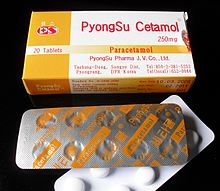
A small number of capitalistic elements are gradually spreading from the trial area, including a number of advertising billboards along certain highways. Recent visitors have reported that the number of open-air farmers' markets has increased in Kaesong and Pyongyang, as well as along the China-North Korea border, bypassing the food rationing system. In addition to food aid, China reportedly provides an estimated 80% to 90% of North Korea's oil imports at "friendly prices" that are sharply lower than the world market price.
North Korea also has a cartoon animation industry, sub-contracting work from South Korean animation studios.
International Trade
China and South Korea are the biggest trade partners of North Korea, with trade with China increasing 15% to US$1.6 billion in 2005, and trade with South Korea increasing 50% to over 1 billion for the first time in 2005. China is North Korea's closest economic partner, accounting for around 70% North Korea's foreign trade.
In 2000, the Centre for the Study of the Capitalist System was established. Increasingly more foreign-invested joint ventures have been set up since 2002. The Pyongyang Business School was established by the Swiss government to help teach students business management.
In 2000, Taiwan began exporting nuclear waste to North Korea for disposal.
European investors have worked alongside North Korea to develop freelance computer programming employment opportunities. The company, Nosotek's homepage, nosotek.com, faced a website defacement in 2013.
In January 2013, North Korea also purchased 16,000 video cameras from China in order to conduct mass surveillance on citizens.
Tourism
Tourism in North Korea is organized by the state-owned Korea International Travel Company. All tourists/visitors are constantly accompanied by one or two guides, who usually speak the tourist's native language. While tourism has increased over the last few years, tourists from Western countries remain few.
Most visitors come from China, Russia, and Japan. For citizens of South Korea, it is almost impossible to get a visa to North Korea; they can get entry permits to special tourist areas designated for South Koreans, such as Kaesong. United States citizens were also subject to visa restrictions, allowed to visit only during the yearly Arirang Festival; these restrictions were lifted in January 2010. Fewer than 2,500 United States citizens have visited North Korea since 1953.
In the area of Mount Kumgang, the company Hyundai established and operates a special tourist area. Travel to this area is possible for South Koreans and United States citizens, but only in organized groups from South Korea. A special administrative region, the Mount Kumgang Tourist Region, exists for this purpose. Trips to the region were suspended after a South Korean woman who wandered into a controlled military zone was shot dead by border guards in late 2008. When tours had not resumed by May 2010, North Korea announced that it would seize South Korean real estate assets in the region.
There are hotels throughout the country, the largest currently operating being the Yanggakdo International Hotel.
Famine
In the 1990s North Korea faced significant economic disruptions, including a series of natural disasters, economic mismanagement and serious resource shortages after the collapse of the Eastern Bloc. These resulted in a shortfall of staple grain output of more than 1 million tons from what the country needs to meet internationally accepted minimum dietary requirements. The North Korean famine known as the "Arduous March" resulted in the deaths of between 300,000 and 800,000 North Koreans per year during the three-year famine, peaking in 1997. The deaths were most likely caused by famine-related illnesses such as pneumonia, tuberculosis, and diarrhea rather than starvation.
In 2006, Amnesty International reported that a national nutrition survey conducted by the North Korean government, the World Food Programme, and UNICEF found that 7% of children were severely malnourished; 37% were chronically malnourished; 23.4% were underweight; and one in three mothers was malnourished and anaemia as the result of the lingering effect of the famine. The inflation caused by some of the 2002 economic reforms, including the Songun or "Military-first" policy, was cited for creating the increased price of basic foods.
The history of Japanese assistance to North Korea has been marked with challenges; from a large pro-Pyongyang community of Koreans in Japan to public outrage over the 1998 North Korean missile launch and revelations regarding the abduction of Japanese citizens. In June 1995, an agreement was reached that the two countries would act jointly. South Korea would provide 150,000 tons of grain in unmarked bags, and Japan would provide 150,000 tons gratis and another 150,000 tons on concessional terms. In October 1995 and January 1996, North Korea again approached Japan for assistance. On these two occasions, both of which came at crucial moments in the evolution of the famine, opposition from both South Korea and domestic political sources quashed the deals.
Beginning in 1997, the U.S. began shipping food aid to North Korea through the United Nations World Food Programme (WFP) to combat the famine. Shipments peaked in 1999 at nearly 700,000 tons making the U.S. the largest foreign aid donor to the country at the time. Under the Bush Administration, aid was drastically reduced year after year from 350,000 tons in 2001 to 40,000 in 2004. The Bush Administration took criticism for using "food as a weapon" during talks over the North's nuclear weapons program, but insisted the U.S. Agency for International Development (USAID) criteria were the same for all countries and the situation in North Korea had "improved significantly since its collapse in the mid-1990s." Agricultural production had increased from about 2.7 million tons in 1997 to 4.2 million tons in 2004.
In 2013, there were reports of famine returning to parts of North Korea and driving some to cannibalism, with the claims that one man dug up his grandchild's corpse to eat and another boiled his child and ate the flesh. Another man was allegedly executed after murdering his two children for food. However, the World Food Program reported malnutrition and food shortages, but not famine.
Crime and law enforcement
The Ministry of People's Security maintains all law enforcement activities at the local level, which includes police and other initiatives. There is also a State Security Department that operates in a similar way to an "Office of the Interior" located in other countries.
Transportation
Two of the few ways to enter North Korea are over the Sino-Korea Friendship Bridge or via Panmunjeom, the former crossing the Amnok River and the latter crossing the Demilitarized Zone.
On 13 October 2011 a train from the Russian border settlement of Khasan made an inaugural run to Rajin in North Korea. The 54 kilometer newly repaired link of the Trans-Korean Main Line was the first step in an effort to rebuild the Trans-Korean rail and integrate it into the Trans-Siberian railroad.
Cars are relatively rare, but as of 2008 some 70% of households used bicycles, which also play an increasingly important role in small-scale private trade. Very few cars and light trucks are made in a joint-venture between Pyeonghwa Motors of South Korea, and the North Korean Ryonbong General Corp at a facility in Nampo North Korea. Another local producer of vehicles is Sungri Motor Plant, which manufactures civilian vehicles and heavy trucks.
There is a mix of locally built and imported trolleybuses and trams in urban centers in North Korea. Earlier fleets were obtained in Europe and China, but the trade embargo has forced North Korea to build their own vehicles.
Rail transport
Choson Cul Minzuzui Inmingonghoagug is the only rail operator in North Korea. It has a network of 5,200 km (3,200 mi) of track with 4,500 km (2,800 mi) in standard gauge. There is a small narrow gauge railway in operation in Haeju peninsula. The railway fleet consists of a mix of electric and steam locomotives. Cars are mostly made in North Korea using Soviet and Chinese designs. There are some locomotives from Imperial Japan, the United States, and Europe remaining in use. Second-hand Chinese locomotives (early DF4Bs, BJ Hydraulics, etc.) have also been spotted in active service.
People traveling from the capital Pyongyang to other regions in North Korea typically travel by rail. However, in order to travel out of Pyongyang, people need an official travel certificate, ID, and a purchased ticket in advance. Because of lack of maintenance on the rail infrastructure and vehicles, the travel time by rail is increasing. It has been reported that the 190 km (120 mi) trip from Pyongyang to Kaesong can take up to 6 hours.
Marine transport
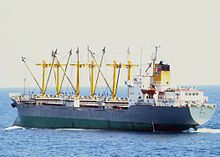
Water transport on the major rivers and along the coasts plays a growing role in freight and passenger traffic. Except for the Yalu and Taedong rivers, most of the inland waterways, totaling 2,253 kilometres (1,400 mi), are navigable only by small boats. Coastal traffic is heaviest on the eastern seaboard, whose deeper waters can accommodate larger vessels. The major ports are Nampho on the west coast and Rajin, Chongjin, Wonsan, and Hamhung on the east coast. The country's harbour loading capacity in the 1990s was estimated at almost 35 million tons a year.
In the early 1990s, North Korea possessed an ocean-going merchant fleet, largely domestically produced, of 68 ships (of at least 1,000 GRT), totaling 465,801 gross register tons (GRT)/709,442 metric tons deadweight (DWT), which includes 58 cargo ships and 2 tankers. There is a continuing investment in upgrading and expanding port facilities, developing transportation—particularly on the Taedong River—and increasing the share of international cargo by domestic vessels.
Air transport
There are several North Korean Airports, although international air connections are limited. There are regularly scheduled flights from the Pyongyang Sunan International Airport – 24 kilometres (15 mi) north of Pyongyang – to Moscow, Khabarovsk, Vladivostok, Bangkok, Beijing, Dalian, Kuala Lumpur, Shanghai, Shenyang along with seasonal services to Singapore and charter flights from Pyongyang to numerous Asian and European destinations including Tokyo and Nagoya. Regular charters to existing scheduled services are operated as per demand. An agreement to initiate a service between Pyongyang and Tokyo was signed in 1990. Internal flights are available between Pyongyang, Hamhung, Haeju, Kaesong, Kanggye, Kilju, Nampho, Sinuiju, Samjiyon, Wonsan, and Chongjin.
All civil aircraft are operated by Air Koryo: 38 aircraft in 2010, which were purchased from the Soviet Union and Russia. From 1976 to 1978, four Tu-154 jets were added to the seven propeller-driven An-24s and two Ilyushin Il-18s; afterwards adding 4 long-range Ilyushin Il-62M, three Ilyushin Il-76MD large cargo aircraft. In 2008, a long range Tupolev Tu-204-300 was purchased along with, in 2010, a larger version the Tupolev Tu-204-100B.
Demographics
North Korea's population of roughly 24 million is one of the most ethnically and linguistically homogeneous in the world, with very small numbers of Chinese, Japanese, Vietnamese, South Korean, and European expatriate minorities.
According to the CIA World Factbook, North Korea's life expectancy was 63.8 years in 2009, a figure roughly equivalent to that of Pakistan and Burma and slightly lower than Russia. Infant mortality stood at a high level of 51.3, which is 2.5 times higher than that of China, 5 times that of Russia, and 12 times that of South Korea.
According to the UNICEF "The State of the world's Children 2003" North Korea appears ranked at the 73rd place (with first place having the highest mortality rate), between Guatemala (72nd) and Tuvalu (74th). North Korea's total fertility rate is relatively low and stood at 2.0 in 2009, comparable to those of the United States and France.
Language
North Korea shares the Korean language with South Korea. There are dialect differences within both Koreas, but the border between North and South does not represent a major linguistic boundary. While prevalent in the South, the adoption of modern terms from foreign languages has been limited in North Korea. Hanja (Chinese characters) are no longer used in North Korea (ever since 1949), although still occasionally used in South Korea. In South Korea, knowledge of Chinese writing is viewed as a measure of intellectual achievement and level of education. Both Koreas share the phonetic writing system called Chosongul in the north and Hangul south of the DMZ. The official Romanization differs in the two countries, with North Korea using a slightly modified McCune-Reischauer system, and the South using the Revised Romanization of Korean. The move toward prohibiting both Roman and Chinese-based characters in North Korea has led to the creation of a number of words and phrases not common in the southern half of the peninsula or in Korean communities abroad.
Religion
Both Koreas share a Buddhist and Confucian heritage and a recent history of Christian and Cheondoism ("religion of the Heavenly Way") movements. The North Korean constitution states that freedom of religion is permitted. According to the Western standards of religion, the majority of the North Korean population could be characterized as non-religious. However, the cultural influence of such traditional religions as Buddhism and Confucianism still have an effect on North Korean spiritual life.
Nevertheless, Buddhists in North Korea reportedly fare better than other religious groups, particularly Christians, who are said to face persecution by the authorities. Buddhists are given limited funding by the government to promote the religion, because Buddhism played an integral role in traditional Korean culture.
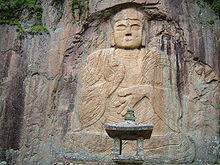
According to Human Rights Watch, free religious activities no longer exist in North Korea, as the government sponsors religious groups only to create an illusion of religious freedom. According to Religious Intelligence the situation of religion in North Korea is the following:
- Irreligion: 15,460,000 (64.3% of population, the vast majority of which are adherents of the Juche philosophy)
- Korean shamanism: 3,846,000 adherents (16% of population)
- Cheondoism: 3,245,000 adherents (13.5% of population)
- Buddhism: 1,082,000 adherents (4.5% of population)
- Christianity: 406,000 adherents (1.7% of population)
Pyongyang was the centre of Christian activity in Korea until 1945. From the late forties 166 priests and other religious figures were killed or disappeared in concentration camps, including Francis Hong Yong-ho, bishop of Pyongyang and all monks of Tokwon abbey. No Catholic priest survived the persecution, all churches were destroyed and the government never allowed any foreign priest to set up in North Korea.
Today, four state-sanctioned churches exist, which freedom of religion advocates say are showcases for foreigners. Official government statistics report that there are 10,000 Protestants and 4,000 Roman Catholics in North Korea.
According to a ranking published by Open Doors, an organization that supports persecuted Christians, North Korea is currently the country with the most severe persecution of Christians in the world. Open Doors estimates that 50,000–70,000 Christians are detained in North Korean prison camps. Human rights groups such as Amnesty International also have expressed concerns about religious persecution in North Korea.
Education
Education in North Korea is free of charge, compulsory until the secondary level, and is controlled by the government. The state also used to provide school uniforms free of charge until the early 1990s. Heuristics is actively applied in order to develop the independence and creativity of students. Compulsory education lasts eleven years, and encompasses one year of preschool, four years of primary education and six years of secondary education. The school curriculum has both academic and political content. North Korea is one of the most literate countries in the world, with an average literacy rate of 99%. According to Shin Dong-hyuk, children imprisoned in concentration camps also receive a form of education.
Primary schools are known as people's schools, and children attend them from the age of 6 to 9. Then from age 10 to 16, they attend either a regular secondary school or a special secondary school, depending on their specialties.
Higher Education
Higher education is not compulsory in North Korea. It is composed of two systems: academic higher education and higher education for continuing education. The academic higher education system includes three kinds of institutions: universities, professional schools, and technical schools. Graduate schools for master's and doctoral level studies are attached to universities, and are for students who want to continue their education. Two notable universities in the DPRK are the Kim Il-sung University and Pyongyang University of Science and Technology, both in Pyongyang. The former, founded in October 1946, is an elite institution whose enrollment of 16,000 full- and part-time students in the early 1990s occupies, in the words of one observer, the "pinnacle of the North Korean educational and social system." There is also a University called the Kim Chaek University of Technology that specializes in information technology and nuclear research.
Health care
North Korea has a national medical service and health insurance system which are offered for free. In 2001 North Korea spent 3% of its gross domestic product on health care. Beginning in the 1950s, the DPRK put great emphasis on healthcare, and between 1955 and 1986, the number of hospitals grew from 285 to 2,401, and the number of clinics – from 1,020 to 5,644. There are hospitals attached to factories and mines. Since 1979 more emphasis has been put on traditional Korean medicine, based on treatment with herbs and acupuncture.
North Korea's healthcare system has been in a steep decline since the 1990s because of natural disasters, economic problems, and food and energy shortages. In 2001, many hospitals and clinics in North Korea lack essential medicines, equipment, running water and electricity.
Almost 100% of the population has access to water and sanitation, but it is not completely potable. Infectious diseases, such as tuberculosis, malaria, and hepatitis B, are considered to be endemic to the country. Life expectancy in North Korea is 63.81 years, occupying the 169th place in the world, according to 2011 estimates.
Among other health problems, many North Korean citizens suffer from the after effects of malnutrition, caused by famines related to the failure of its food distribution program and "military first" policy. A 1998 United Nations (UN) World Food Program report revealed that 60% of children suffered from malnutrition, and 16% were acutely malnourished. As a result, those who suffered during the disaster have ongoing health problems.
Culture and arts
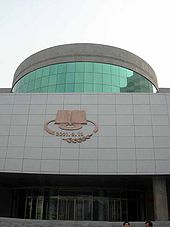
North Korea shares its traditional culture with South Korea, but the two Koreas have developed distinct contemporary forms of culture since the peninsula was divided in 1945. Historically, while the culture of Korea has been influenced by that of neighbouring China, it has nevertheless managed to develop a unique and distinct cultural identity from its larger neighbour.
Literature and arts in North Korea are state-controlled, mostly through the Propaganda and Agitation Department or the Culture and Arts Department of the Central Committee of the KWP.
Korean culture came under attack during the Japanese rule from 1910 to 1945. Japan enforced a cultural assimilation policy. During the Japanese rule, Koreans were encouraged to learn and speak Japanese, adopt the Japanese family name system and Shinto religion, and were forbidden to write or speak the Korean language in schools, businesses, or public places. In addition, the Japanese altered or destroyed various Korean monuments including Gyeongbok Palace and documents which portrayed the Japanese in a negative light were revised.
In July 2004, the Complex of Goguryeo Tombs became the first site in the country to be included in the UNESCO list of World Heritage Sites.
In February 2008, The New York Philharmonic Orchestra became the first US orchestra to perform in North Korea, albeit for a handpicked "invited audience." The concert was broadcast on national television. The Christian rock band Casting Crowns played at the annual Spring Friendship Arts Festival in April 2007, held in Pyongyang.
A popular event in North Korea is the Mass Games. The most recent and largest Mass Games was called " Arirang". It was performed six nights a week for two months, and involved over 100,000 performers. Attendees to this event in recent years report that the anti-West sentiments have been toned down compared to previous performances. The Mass Games involve performances of dance, gymnastics, and choreographic routines which celebrate the history of North Korea and the Workers' Party Revolution. The Mass Games are held in Pyongyang at various venues (varying according to the scale of the Games in a particular year) including the Rungrado May Day Stadium, which is the largest stadium in the world with a capacity of 150,000 people. In addition, a Kim Chaek People's Stadium was built for events at 40°41'0"N 129°11'47"E.
North Korea employs artists to produce art for export at the Mansudae Art Studio in Pyongyang. Over 1,000 artists are employed. Products include water colors, ink drawings, posters, mosaics and embroidery. Socialist realism is the approved style with North Korea being portrayed as prosperous and progressive and its citizens as happy and enthusiastic. Traditional Korean designs and themes are present most often in the embroidery. The artistic and technical quality of the works produced is very high but other than a few wealthy South Korean collectors there is a limited market because of public taste and reluctance of states and collectors to financially support the regime.
Sports
Perhaps the most well known sporting event in North Korea is the annual Arirang Festival. The main attraction of Arirang is the mass gymnastics display. In football, fifteen clubs compete in the DPR Korea League level-one and vie for both the Technical Innovation Contests and the Republic Championship. The national football team, Chollima, compete in the AFC and are ranked 105 by FIFA as of 26 May 2010. The team competed in the FIFA World Cup in 1966 and 2010. In hockey, North Korea has a men’s team that is ranked 43rd out of 49 and competes in Division II. The women’s team is ranked 21 out of 34 and competes in Division II.
North Korea has been competing in the Olympics since 1964 and debuted at the summer games in 1972 by taking home five medals, including one gold. To date, North Korea has medaled in every summer Olympics in which they have participated. The IOC Code is PRK.
North Korea boycotted the 1988 Summer Olympics in neighboring Seoul. At the Athens Games in 2004, the North and South marched together in the opening and closing ceremonies under the Unification Flag, but competed separately.
The martial art taekwondo originated in Korea. In the 1950s and 1960s, modern rules were standardised and taekwondo became an official Olympic sport in 2000. Other Korean martial arts include taekkyeon, hapkido, tang soo do, kuk sool won, kumdo and subak.
In addition, the board game Yut is a team sport and televised on North Korean stations.



